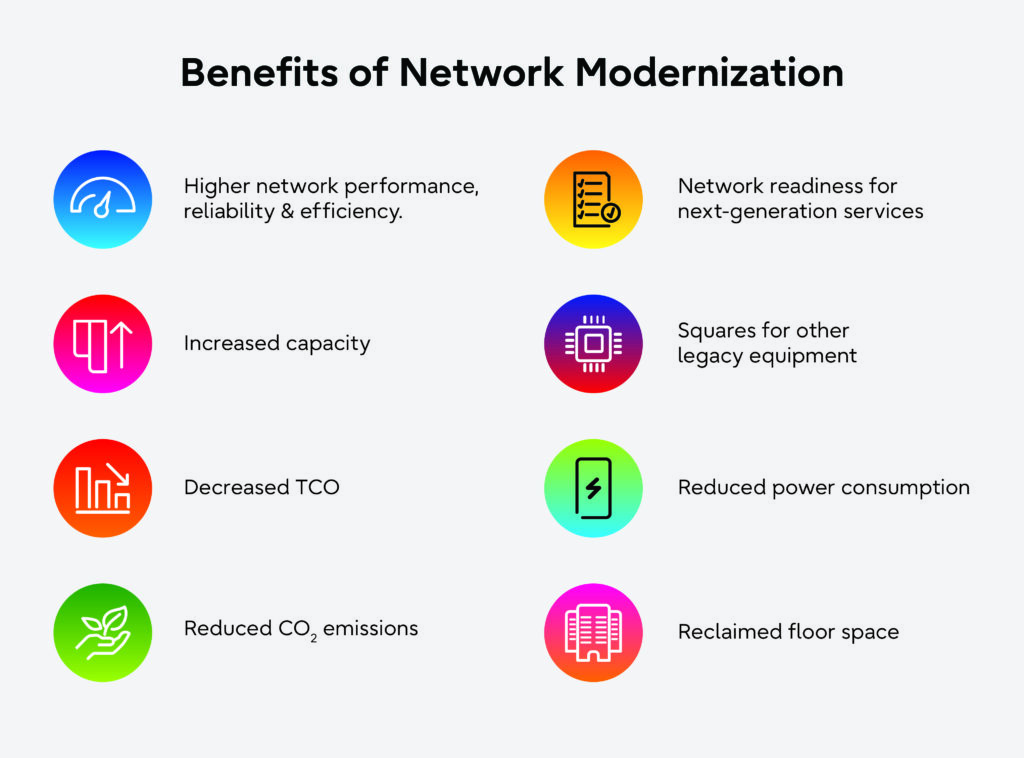
Take the first step in network transformation with network modernization
Technology evolves exponentially. The lag time between disruptive innovations—which gives network managers time to adapt and catch up—is growing shorter. As a result, many Communication Service Providers (CSPs) may feel like they’re falling behind. Network transformation has become an important strategy for CSPs who want to catch up and ensure their network infrastructure evolves to meet the needs of their organization. The challenge for those considering a network transformation initiative is to decide what it means to their business and how to start. For some, network transformation means a complete network overhaul, while for others it’s a gradual system-by-system process of replacing legacy TDM/SONET technologies with modern packet-switched systems. Still others define it in more vague terms as the process of fundamentally altering an organization’s network infrastructure to better serve its evolving business and technology needs.
While an accepted definition of network transformation is difficult to pin down, CSPs are hoping it will improve their network’s value, reduce total cost of ownership, and increase manageability. According to a recent study by Market Research Future, the global market value of network transformation services is projected to grow from $7.04 billion (USD) in 2023 to $51.158 billion by 2032, which is a Compound Annual Growth Rate (CAGR) of 28.12% over a nine-year period.1

So, what are network owners and managers hoping to gain from their network transformation investment? One study shows that 90% of CSP finance executives are hoping to achieve improved network availability while optimizing the total cost of their networks.2 The big question is how and where to start their network transformation?
A logical first step is network modernization
A good first step involves assessing network office locations to identify outdated and/or redundant facilities, equipment, and circuits. These assets are often the remnants of past network acquisitions. Some may be idle, while others are still passing traffic but are no longer supported by the manufacturer. As a result, the overall cost to operate and maintain these legacy assets often outweighs the amount of revenue they generate. To recoup the cost and real estate potential, CSPs are increasingly turning to a network modernization strategy.
Network modernization typically refers to the process of analyzing the systems, circuits, and equipment in selected central/regional facilities in order to decommission and remove redundant or non-functioning components, consolidate resources, and/or vacate non-productive locations. In addition to providing a tangible first step toward network transformation, the process can yield valuable information on the network’s current operational state, weed out inefficiencies, while delivering immediate Operating Expenses (OpEx) and real estate savings.

As the industry prepares to address emerging challenges, like Generative Artificial Intelligence (AI) and Open RAN, many Tier 1 service providers view network modernization as an opportunity to assess what may be involved in a larger network transformation initiative. Results from a recent Heavy Reading survey estimate that CSPs will eliminate 10% – 30% of their offices over the next two years, which they expect will generate annual cost savings of 5% -20%.
Beyond potential cost savings and sustainability benefits, network modernization helps lay the foundation for a successful network transformation initiative. For example, eliminating overlay networks will ultimately support network transformation objectives such as zero-touch management and lights-out data centers.3
Additionally, a network modernization project includes reconciling the Operating Support System (OSS) records for the affected circuits. Depending on the network, the records database can be large and bloated. The process of reconciling and cleaning the OSS databases can yield enormous value, enhancing the provider’s ability to coordinate customers, services, resources, processes, and activities, which further pave the way for a successful network transformation.
While one might assume that network modernization efforts are driven by network managers or their CIOs/ CTOs, Heavy Reading research shows that the CEO and CFO represent 64% of all CSP roles selected to drive a site exit/consolidation initiative. This information underscores the value and importance of a network modernization effort.
Fujitsu helps make network transformation definable and achievable
A 2024 survey by MeriTalk4 commissioned by Dell Technologies found that 90% of CSPs believe network transformation is critical to their organization’s survival. However, 96% of CSPs also said their network transformation vision is lagging, which holds them back from giving their customers an ideal network experience. Why the disconnect? Perhaps because, while the potential benefits of network transformation—increased agility, lower cost, improved security, operational efficiency, scalability, etc.—are easy to visualize, there is no pre-defined path to success.
Network modernization is a definable and achievable first step to network transformation. In the short term, it can improve operational efficiency, lower OpEx and real estate costs, while simplifying network complexity. In the long term, network modernization provides critical insights into the state of the network while clearing the network clutter and enabling decision-makers to understand what needs to be done.
As a global provider of CSP network solutions and services, Fujitsu has a proven track record of success in network modernization projects. Our network modernization teams helps CSPs streamline and update their multivendor network locations using our proven six-step process:
- Analyze your current network elements and locations
- Consolidate and compress circuits and equipment
- Migrate individual devices: like for like, TDM to IP
- Retire non-traffic bearing hardware, recover legacy assets
- Replace discontinued systems with new, multiservice systems
- Record all audit and reconciliation activities
For more information about Fujitsu’s network modernization services, visit our site.
Gain Insights into Network Modernization
For a better understanding of decisions and drivers behind a network modernization strategy, download a full copy of the Heavy Reading white paper, CSP Office Consolidation and Cost Reduction.
1. Network Transformation Market Overview; Market Research Future, research report; August 2024
2. Network-led transformation for growth; Accenture, research report; July 11, 2023
3. CSP Office Consolidation and Cost Reduction; Heavy Reading, white paper; August 2024
4. Network Transformation – Global Insights for CSPs; MeritTalk Telecom, industry report; May 2024